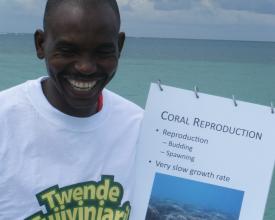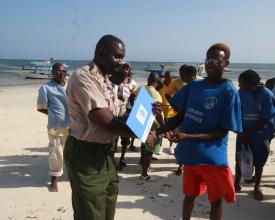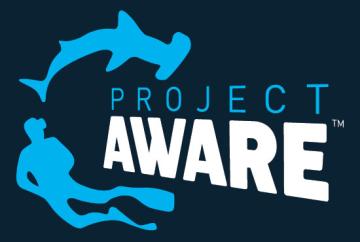The use of interpretation to influence the behavior of snorkelers
Full Solution
Throughout the 3 day interpretive workshop discussion was used as a tool to engage participants and encourage contributions from all. One such focused discussion group gave rise to the code of conduct all boats will adhere to.
Sander den Haring
This solution addresses snorkeler impacts and dissatisfaction in the Mombasa Marine Park and Reserve (MMPR). James Cook University (JCU) and CORDIO delivered interpretive training to the snorkel industry to encourage pro-environmental snorkel behavior, enhance visitor experience and build sustainability. A major output was the creation of a code of conduct created by members of the snorkel industry. Results included more pro-environmental snorkel behaviors and enhanced visitor experience.
Last update: 28 Mar 2019
4520 Views
Context
Challenges addressed
Snorkelers create impacts when snorkeling such as contacting the reef substrate, feeding fish and siltation.
During snorkeling excursions there is no exchange of information, minimal guiding and use of poor snorkeling equipment. This has led to snorkeler dissatisfaction.
Research has shown that snorkelers want to learn more about corals, fish and the marine park they are visiting.
Location
Mombasa Marine Park and Reserve (MMPR), Mombasa, Kenya
East and South Africa
Process
Summary of the process
The solution we applied in the Mombasa Marine Park and Reserve was created as a response to snorkeler impacts whilst snorkeling. Background research found that snorkelers were creating numerous intentional contacts on the living substrate whilst snorkeling. To determine why snorkelers were making these intentional contacts, salient beliefs of that specific behavior were identified. These salient beliefs are those beliefs that truly drive the behavior that needed influencing (in this case touching the coral reef). An interpretive workshop was then delivered to the snorkeling operators to introduce them to the concept of interpretation, how it can benefit their clientele and providing an opportunity for them to deliver interpretive efforts in an instructional setting. Various tools were created to assist in delivering these interpretive efforts that the operators could make use of during their future excursions. Finally, feedback sessions were organized to monitor the use of the materials, the efficacy of the interpretive efforts and these sessions also presented an opportunity for operators to discuss successes and work through challenges.
Building Blocks
Identifying salient beliefs of target audience
The driving beliefs that impact behavior in any region must first be identified before these salient beliefs can be targeted. These salient beliefs can vary between different geographic regions and/or different target audiences (tourists, residents, citizens, geographic origins, life styles etc..). If these salient beliefs are not adequately researched, any interpretive efforts delivered would have the result of searching for a needle in a haystack, as all interpretive messages will be based on targeting these salient beliefs. In this instance the salient beliefs of the snorkeling clients were identified, and more specifically, the beliefs they held towards “not contacting the reef substrate”. Structured interviews exploring their descriptive norms, normative norms, control beliefs and attitudes were conducted to identify their salient beliefs. Results of these interviews will distinguish between compliers and non-compliers and hence the salient beliefs for any particular behavior can be identified. Once these salient beliefs were identified, interpretive messages were created focusing on these salient beliefs.
Enabling factors
A willing snorkel audience to partake in the interviews is essential to gather the necessary information. In my experience if the interview is not too long (more than 5 minutes) than most people will be willing to assist. The interview in question consists of 8 questions that are answered in freelisting style and should not take more than 5 minutes per person.
Lesson learned
Having clear, concise and similar (for al the interviews) wording in the interviews is essential. Avoid double negatives and refer to a specific behavior that needs to be influenced. The more general the behavior is, the less likely the salient beliefs will be identified.
Resources
Interpretive training workshop
The interpretive workshop is the main medium used to deliver the interpretive efforts (the solution) to the snorkeling clientele (or any other target audience). The workshop trains the snorkel operators (or any other body responsible for delivering interpretive messages) to deliver interpretive efforts. These interpretive efforts target salient beliefs identified in the previous building block to influence the behavior of the target audience. The Sea Through the Looking Glass solution used in the Mombasa Marine Park used expert presentations, group discussions and role-play scenarios to make the snorkel operators comfortable with the interpretation they would offer their clients.
Enabling factors
The target audience for the workshop must be willing. Dialogue between all parties leading up to the workshop must accurately convey what the workshop is and what benefits the target audience will gain from it. If the target audience sees no benefit, they will not sacrifice their time to be part of the workshop.
Lesson learned
As discussed above, communication is essential. If certain key persons are neglected, not invited, or over stepped the workshop could be doomed to failure.
Resources
Interpretive tools to influence behavior
To facilitate the interpretive efforts reaching the snorkeling clients a set of materials was designed and created to be used by the snorkel operators. This set of materials included: a 20-sided, A3, waterproof flip chart depicting organized information on the reef environment, a double sided water proof marine life identification slate, a salesman folder (used to sell excursions in a more organized and professional manner), flags used to brand the boats that undertook the training and deliver interpretive efforts, a uniform branded with the workshop logo and sign boards placed along the beach explaining what the branded logo stands for (so clients can choose their boats accordingly) and also depicting the newly developed code of conduct all boats will adhere to. This code of conduct was developed during the workshop in one of the group discussions.
Enabling factors
Available funding for material production and free distribution of materials.
Lesson learned
It is important to create easy to use and clear materials that any of the target audience (in this case coastal snorkel boat operators) can use. Apart from just designing these materials, it is essential that training be included in how to use these materials. This offers the target audience an opportunity to ask questions about the materials or overcome their fears of not understanding what each material is used for.
The training session described above was essential in making the target audience more comfortable with the materials. Some of the participants who were too shy during the training to make use of this practice session were not seen using the materials after the workshop. Showing the target audience how easy it is to use these materials is very important.
Post training monitoring of progress and feedback
The monitoring of the interpretive efforts over time is essential as it provides continued reinforcement that the interpretation is working. Furthermore, it also acts as an opportunity for the operators to come together and discuss openly challenges faced, challenges overcome and success stories they have enjoyed. Learning from each other is the best possible feedback and having a facilitated opportunity to do this makes it realistic and beneficial to the overall effort of protecting the marine resources. The Kenya Wildlife Service (KWS) took on the responsibility of monitoring the interpretive efforts. The KWS was able to oversee a few meetings with various operators to discuss progress but sadly the monitoring momentum slowed down after the initial meetings.
Enabling factors
Having regular meetings is essential. Do not assume that since the interpretive efforts are working well 2 weeks after the workshop that they will continue to do so for many more weeks thereafter. Continual reinforcement is a necessity.
Lesson learned
In this particular solution the feedback sessions were appointed to a third party. Sadly this third party did not uphold their commitment to host these feedback sessions and as a result the interpretive efforts gradually reduced over time. When the same workshop was conducted in another Kenyan marine park efforts were made to maintain these feedback sessions and as a result interpretive efforts worked better over the long run.
Impacts
Snorkelers of similar experience, demographics, attitudes and intentions were observed before and after the implementation of the interpretive efforts during snorkeling excursions in the MMPR. Interpretation resulted in a) increased pro-environmental snorkel behaviors and b) enhanced visitor experience. On snorkeling trips with interpretive efforts snorkel behaviors consisted of increased intentional contacts with dead substrate, standing on dead substrate and standing on seagrass rather than living substrate. There were significantly less damaging contacts to the reef. Snorkelers on interpretive excursions stated that they had received a presentation and that they were more satisfied with the amount of interaction, the use of pictures and the wording of the information compared to their peers who did not receive any structured interpretive efforts. Their guides were instrumental in transferring information to these snorkelers and as a result, these snorkelers were more satisfied than the snorkelers of the no-interpretation group. Lastly, snorkelers in the interpretive group were found to think more critically of the messages that were presented, another sign of successful interpretation that contributes to influencing behavior.
Beneficiaries
Snorkeling operators in the MMPR were able to sell a new "product"; snorkeling customers and the snorkelers gained an enhanced snorkeling experience as a result; the reef was offered increased protection.
Story
I recently completed a PhD researching the use of interpretation to influence the behavior of recreational resource users. The solution described above made up one of the chapters of my thesis. The work involved with the training workshop was the most hands-on aspect of my PhD, mostly because it was an application of my research. I am more application-oriented than theoretical so for me this was a great bonus. The work I completed on this training workshop I have been able to replicate in other areas along the Kenyan coast, which again, strengthens the application-approach this training workshop offers. What I remember most about this training workshop is the amount of interest there was from the target audience (in this case the snorkel operators of the marine parks). The target audience was asked to sacrifice 3 days of their day-to-day work to attend this workshop. Sure, we provided lunch and transport, but did not offer any payment to any of the participants to attend (this is not usually the norm along this stretch of Kenyan coastline). For the first series of workshops, we had targeted 100 participants to be spread out over 2 training sessions. First we would train the first 50 for three days, then the remaining 50 in the following 3 days. For the first session we struggled to get 37 participants. This was not unusual as no one really knew what to expect, or if it would be worth sacrificing valuable time away from their usual day at work on the beach. However, by the time the first group had graduated from the workshop, word had obviously spread. The following morning when the second group was due to attend we had 97 eager participants waiting outside the venue (50 more than we had planned for). We managed to squeeze 65 participants into the conference room and vowed to complete a third training in the near future for the remaining hopefuls (which we did). The comraderie and enthusiasm that this second group exhibited (especially during the practical role-play scenarios on the last day) was truly inspiring. I couldn’t help but think that if such an interest existed with all snorkel operators, then we must have done something right in the training workshop. That was at the time. Having now seen the results of my research and how effective the training actually was, I am a firm believer in the practical applications of such interpretive efforts to protecting and conserving the marine resources.










